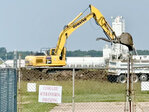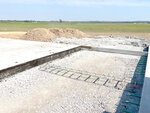



Improvements to the runway at Perryville Regional Airport, which began on Aug. 1, are progressing. The project is expected to be completed sometime in October.
The airport, which features the longest runway of any airport between St. Louis and Memphis, has a fascinating history.
Built by U.S. Army Air Forces in 1942, Chester Army Airfield was a primary pilot training facility for the Southeast Training Center, later known as the Eastern Flying Training Command. The airport used Fairchild PT-19s as its primary training aircraft, and Anderson Air Activities provided flight training, which ended in May 1944.
After the end of World War II, the airport was deeded to the City of Perryville in 1947 and has been operational ever since.
Airport Manager Barbara Maxwell, who has worked at the airport for six-and-a-half years, said the runway project has been a work in progress for the past decade.
“The original runway was built in 1944,” she said. ”Then, when Sabreliner was here, it was extended. Over time, the runway started deteriorating. [City Administrator Brent Buerck] and the board of aldermen have been working to get funding to have it either replaced or reconstructed. We were approved for funding from the FAA and MoDOT around a year ago, with the city paying a certain percentage, as well.
“We're basically getting a brand-new runway. They are reducing the length of the runway from 7,003 feet to 6,403 feet, and they decided to overlay the concrete with asphalt to level it all out, leaving the current runway as it is. To shorten it, they stripped away the 500 feet on the south end facing Highway H. Then, after they overlaid the rest of the runway with asphalt, they came back with 9 to 10 inches of concrete on top of that. Our runway is 100 feet wide.
According to Maxwell, there was a good reason for shortening the runway.
“The threshold is where the pilots aim when they come in for a landing, and we had what is called a displaced threshold,” she said. “There are areas on either side of the runway and at the ends of the runway that are called the runway safety area. The way our airport had been designed before the runway safety area traveled over Highway H. Because of that, they had to displace the threshold.
“Normally, they would aim for the end of the runway, but because of that, it was moved further in. I couldn't tell you how far in it was, but where those markings were, it was because of the overrun for the runway. Unfortunately, Highway H was there. There was talk many, many years ago of them possibly purchasing land and having Highway H move. Well, that's probably not going to happen. The alternative was to shorten it. It’s a portion of the runway that is rarely used anyway.”
Now that the airport no longer has a displaced threshold, it has the proper amount of footage at the end of the runway.
Maxwell explained one of the main reasons why the runway was in such disrepair.
“Part of the deterioration was concrete coming up,” she said. “We're talking rock that was probably the size of your hand. It cracked all the way through the runway. Originally, the runway was only six inches thick, so it wasn’t thick at all. When Faber Weiner was here, we had large aircraft that came in. They had C-130s come in. They had a government contract with the Navy, so there were larger aircraft.
“Now, West Star Aviation is on our airfield. There are really large aircraft that they do maintenance work on. And once they do whatever they do, they take off. The weight limits of the aircraft coming in, were heavier than what our runway was rated for. When you put something really heavy on a runway that's not rated for that, you're going to have what we have. They were a big factor in us being able to get the funding to begin with because you don't really need that strength for the smaller transient traffic.”
Because of the runway’s length, the airport sees a lot of jet traffic, and once the renovation is complete, there may be a noticeable increase.
“They come in because they're doing business here in Perryville or the surrounding area,” Maxwell said. The jet traffic comes here because our runway is really long. The runways in Farmington and Fredericktown are too short. They won't even attempt to land there, especially if it's raining, so they'll end up coming to Perryville, renting a car and driving to wherever they need to go.
“So, the work on the runway will be great for business. The larger aircraft that came in that were not going in for maintenance were the ones who could really notice there were some issues with the runway. Some places were a foot higher than other parts of the runway. When they landed, they could feel the dip in it. It's going to be great for them. We'll have this brand new runway that will have new lighting and new striping. It’ll definitely be a tool for our area to have a runway like this at the airport.”
According to Maxwell, the airport is planning a grand opening for the runway sometime in October. She also noted that there are electric vehicle charging stations on site for cars and planes.